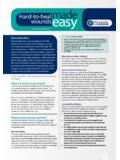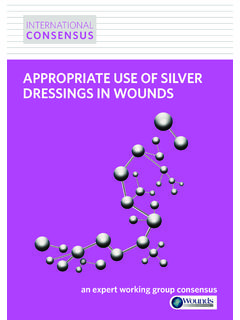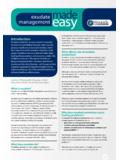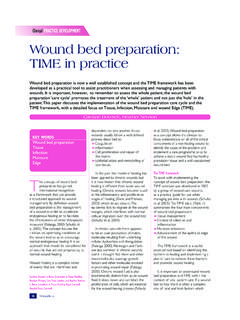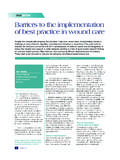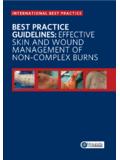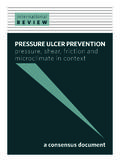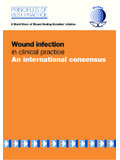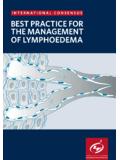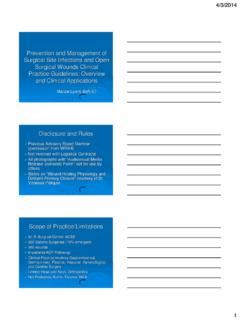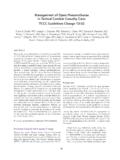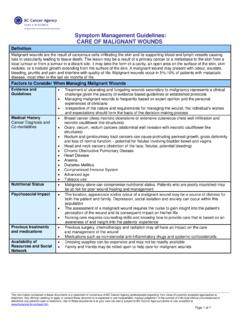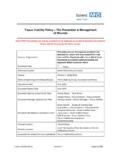Transcription of Iodine madeeasy - Wounds International
1 IntroductionIodine is a highly effective topical antimicrobial that has been used clinically in the treatment of Wounds for more than 170 years. It has a broad spectrum of antimicrobial activity with efficacy against bacteria, mycobacteria, fungi, protozoa and viruses and can be used to treat both acute and chronic wounds1. It is also relatively inexpensive and easy to use, but is often underused as a topical antiseptic due to its perceived : Sibbald RG, Leaper DJ, Queen author details can be found on page is Iodine ? Iodine is a natural dark violet, non-metallic element that plays a key role in human metabolism. It is essential for the production of thyroid hormones and an Iodine deficiency can result in hypothyroidism. Iodine occurs naturally in the form of iodide ions in sea water, fish, oysters and certain seaweeds2. It can also be found in vegetables grown in Iodine -rich soil and dairy products. It has been described as the most potent antiseptic available is the history of Iodine in wound healing?
2 In the 4th century BC, before Iodine had been discovered, Theophrastus, a pupil of Aristotle, recorded that Iodine -rich seaweeds could be used to reduce the pain of sunburn4. One of the first antiseptic Iodine preparations to be used in wound care was Lugol s solution containing elemental Iodine and potassium in water, which was developed in 18295. This solution was also used to treat Wounds in the American Civil War. The antimicrobial properties of Iodine were first demonstrated in 1882 by Davaine6. In the First World War, Iodine was found by Alexander Fleming to reduce the incidence of gas gangrene in the Wounds of soldiers when compared to carbolic acid7. Since the mid-19th century, Iodine -based preparations have also had an important role in the prevention of surgical site infections. Povidone Iodine preparations are popularly used as an antiseptic to prepare the patient s skin before surgery and are also used by surgeons and theatre staff as a skin cleanser and antiseptic in preoperative hand uses of Iodine involved aqueous and alcoholic Iodine preparations, which were associated with unpleasant side effects including pain, irritation and skin is Iodine safer today?
3 Iodophors were developed in the 1950s to overcome the side effects associated with elemental Iodine . These were found to be safer and less painful, but just as effective as elemental Iodine , allowing widespread use. Bonding Iodine with another molecule makes it less toxic and instead of high concentrations of Iodine being released in a single application, the Iodine is slowly released from the reservoir carrier molecule over a sustained period of are preparations that bind Iodine to a solubilising agent or carrier. The water-soluble complex allows the slow release of a low concentration of free Iodine when the carrier comes into contact with wound exudate. This controlled release of low concentrations of Iodine helps to minimise the negative side effects of using free elemental Iodine . Modern Iodine preparationsThe two most commonly used iodophors in modern wound dressings (Table 1) are:n Povidone Iodine (PVP-I): a chemical complex of polyvinylpyrrolidone (also known as povidone and PVP) and elemental Iodine .
4 Examples include dressings such as Inadine (Systagenix) and solutions such as Betadine (Purdue Products) and Braunol (B Braun)n Cadexomer Iodine : an Iodine and polysaccharide complex, such as Iodoflex (Smith and Nephew) and Iodosorb (Smith and Nephew), which can be used as antiseptic fillers, particularly in cavity Wounds . Povidone Iodine preparations were introduced in the 1960s and it is now the most common iodophor in clinical use. It is available in different formulations, including solution, cream, ointment, spray and wound is the evidence to support Iodine use?There is extensive evidence to support the use of povidone Iodine in wound healing8 (Table 2), but its use is not without controversy due to perceived issues with toxicity, systemic madeeasyIodines1 Volume 2 | Issue 2 | May 2011 and delayed healing. It has been suggested that Iodine has a negative impact on cells involved in the wound healing process and because of this its safety and efficacy have been questioned.
5 Some reviews have analysed the conflicting evidence and have found that studies based on animal models tend to support the argument for Iodine s cytotoxicity, whereas human studies suggest that PVP-I can help the wound healing process by reducing bacterial load and decreasing infection rates9,10. One study demonstrated that not only does PVP-1 significantly improve the healing rates of chronic venous leg ulcers, but also that it lacks cytotoxicity in efficacy of cadexomer Iodine has been demonstrated using both animal models and clinical studies. Cadexomer Iodine was found to significantly reduce symptoms associated with infection (eg exudate, erythema, oedema and pain) in patients with pressure ulcers12 and venous leg ulcers13. In addition to providing an antimicrobial effect, in vitro studies have reported a lack of toxicity for human fibroblast activity14 and that cadexomer Iodine may increase epithelialisation of chronic wounds15,16. However, its mode of action is not understood and further research is needed to determine whether wound aetiology has a contributory role8.
6 How does Iodine work as an antimicrobial? Iodine s exact antimicrobial mode of action is not fully understood, but it is believed to be associated with its ability to rapidly penetrate the cell wall of micro-organisms17. Schreier et al3 also investigated the effects of PVP-1 on microbial cells and found that it affects the structure and functions of enzymes and cell proteins and damages bacterial cell function by blocking hydrogen bonding and altering the membrane structure1. These multiple modes of action ensure the rapid death of microbes and help to prevent the development of bacterial resistance. Because the microbicidal action of Iodine is related to several directly toxic effects on the cell wall, rather than through specific molecular pathways (as used by antibiotics), resistance is highly unlikely and reports of Iodine -resistant strains are exceptionally rare (Figure 1) Iodine effective against MRSA?There is substantial in vitro evidence demonstrating that PVP-I is a highly effective and broad spectrum antimicrobial.
7 Activity has been demonstrated against both common bacterial wound isolates18,19 and antibiotic-resistant species20. Lacey and Catto21 determined that more than 99% of meticillin-resistant Staphylococcus aureus (MRSA) cells were killed within 10 seconds of exposure to PVP-I. Mertz et al22 found that cadexomer Iodine significantly reduced MRSA and total bacteria in partial thickness porcine Wounds compared with a no-treatment control and a vehicle group. Is Iodine effective against biofilms? At the most basic level, a biofilm can be described as being bacteria embedded in a slimy, protective mucopolysaccharide effectiveness of Iodine in the management of biofilm is currently unclear, although it is known that low dose, slow release Iodine is effective in killing free-floating planktonic micro-organisms24 and is therefore likely to be a good choice of Table 1 wound dressings containing Iodine (adapted from Boothman, 20108)ProductDistributorIodine formAvailable Iodine contentDescriptionBraunovidon ointment/ointment gauzeB BraunPV-110% per 100g ointmentColloidal ointment baseInadine w/wKnitted viscose meshIodosorb Smith & NephewCadexomer w/wMatrix dressingIodosorb ointmentSmith & NephewCadexomer w/wMacrogol ointment baseIodosorb powderSmith & NephewCadexomer w/wCadexomer Iodine beadsIodoflex Smith & NephewCadexomer w/wMacrogol ointment base with gauze backingIodozyme ArchiMedIodine< w/wHydrogel dressingRepithel w/wLiposome hydrogelNote.
8 % w/w describes the percentage solution Table 2 Clinical studies featuring Iodine (from 1980 to present)Study referenceTherapyDesignSelection criteriaClinical outcomesHomann HH, et al. Ann Plast Surg 2007; 59(4): 423 7 Liposome PVP-I hydrogel vs silver sulfadiazineRandomised controlled trial (n=43)Partial-thickness burnsHealing was found to be significantly faster in the hydrogel group (p< ) and an improved cosmetic result was also noted. Without the inclusion of a non-antimicrobial control, it is difficult to determine whether the PVP-I hydrogel does increase the rate of healing or alternatively if silver sulfadiazine may have a delaying SA, et al. J Invest Dermatol 2006; 126(12): 2731 3 Different concentrations of PVP-I on fluid collected from chronic venous leg ulcers incubated with a range of povidone Iodine concentrationsIn vitro research on wound fluid from seven patientsChronic venous leg ulcersAt the higher PVP-I concentrations, elastase and plasmin activity was reduced significantly in the four wound fluids examined.
9 It is proposed that this beneficial effect may contribute towards improved healing rates in chronic woundsKumar BP, et al. Int J Oral Maxillofac Surg 2006; 35(8): 765 6 Irrigation with PVP-I vs salineRandomised controlled trial (n=50)Oral surgery woundsCessation of bleeding was achieved in 19 patients treated with PVP-I (76%) and 5 in the saline group (20%) (p< )Fumal I, et al. Dermatology 2002; 204 (Suppl) 1: 70 74 Povidone- Iodine vs silver sulfadiazine or chlorhexidine digluconate for six weeksComparative study (n=17 patients with at least two similar leg ulcers)Chronic leg ulcersCompared with the control lesions, both the healing rate and time to healing of the leg ulcers showed a modest improvement at the sites receiving silver sulfadiazine (2 7%) or chlorhexidine digluconate (-1 to 5%). By contrast, PVP-I increased significantly the healing rate (4 18%, p< ), and the time to healing was reduced by 2 9 weeks (p< )Vogt PM, et al. wound Repair Regen 2001; 9(2): 116 22A novel liposome PVP-I hydrogel complex vs chlorhexidine gauzeMonocentric, randomised, open, phase II pilot study (n=36)Meshed skin graftsTreatment with the PVP-I hydrogel resulted in significantly faster epithelialisation (p= ), better antiseptic efficacy (p= ), improved wound healing quality (p= ) and a lower incidence of graft loss (p= ) in comparison with chlorhexidine gauze Miyachi Y, Imamura SJ.
10 Dermatol Treat 1997; 1: 191 93 Sugar (70%) and povidone- Iodine (3%) paste for a three-year periodClinical study treating refractory cutaneous ulcers (n=168)Traumatic, venous and ischaemic, post-burn and diabetic ulcersIncreased granulation tissue formation and a reduction in the size, depth and bacterial contamination of Wounds of mixed aetiology Konig B. et al, Dermatology 1997; 195 Suppl 2: 42 8 PVP-I and the effect on exotoxins and enzymes In vitro studyNot specifiedEndotoxins and exotoxins released by bacteria have been implicated in delayed wound healing; povidone Iodine was found to inactivate bacterial exotoxins such as phospholipase C and lipase and inhibit their further generation. Furthermore, destructive cytokines and enzymes released by neutrophils in response to bacterial colonisation were also found to be rard-Franchimont C, et al. Dermatology 1997; 194(4): 383 7 PVP-I in combination with hydrocolloid dressings vs hydrocolloid dressings alone for four weeksClinical study in 15 female patients (age range 57 73)Chronic leg ulcersPVP-I accelerated the rate of venous leg ulcer healing when evaluated against hydrocolloid dressings alone.
